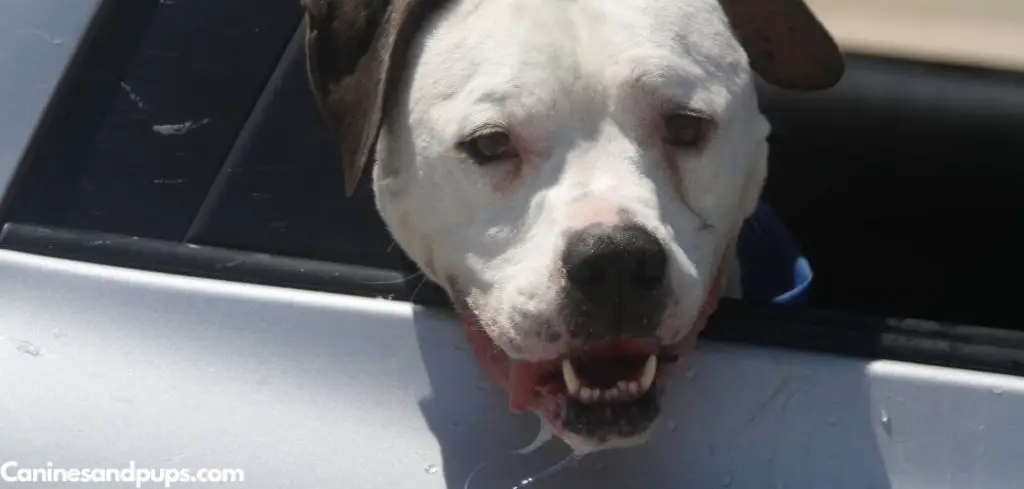Seeing your dog panting and drooling in the car can be stressful and confusing, especially if it happens every time you travel.
We outline the common reasons for panting and drooling in the car, what you can do at home, and when to seek veterinary help.
Table of Contents
Dog Panting and Drooling in The Car — Why It Happens
Dogs often pant and drool in the car due to motion sickness, stress, overheating, or excitement. Some dogs struggle with nausea when the vehicle moves, while others may feel nervous or overstimulated by the experience.
Panting helps them regulate temperature and cope with stress, while drooling is commonly linked to nausea or anxiety.

Dog Panting and Drooling in The Car: Common Causes
Motion Sickness
Motion sickness is one of the most common reasons dogs pant and drool during car rides. The movement of the car can upset your dog’s inner ear balance, leading to nausea.
This discomfort causes drooling, licking lips, and sometimes vomiting. Panting may occur as your dog tries to cope with the uneasy feeling.
Puppies and younger dogs are particularly prone to motion sickness, though some grow out of it as they age.
Read more: Dog Panting and Drooling at Night (Why it happens)
Anxiety and Stress
For many dogs, the car is a source of fear or stress. This may be because they associate it with trips to the vet, loud noises, or the unfamiliar sensation of moving at high speeds.
Anxiety triggers panting as part of the body’s stress response and can also cause excessive drooling.
A stressed dog may also tremble, whine, or pace during the ride, showing clear signs of distress.
Heat and Overheating
Cars can heat up quickly, even with the windows cracked. When dogs become too warm, they pant heavily to regulate their body temperature.
If the environment is too hot, panting may be accompanied by thick drool, restlessness, and signs of dehydration.
Overheating in a car can quickly escalate into heatstroke, which is a medical emergency. Even short trips in warm weather can put your dog at risk.
Excitement and Overstimulation
Not all panting and drooling in the car comes from fear or sickness. Some dogs get overly excited during car rides.
They may anticipate going to the park, beach, or another fun location. This heightened excitement can trigger heavy panting and sometimes drooling as their adrenaline levels rise.
Dogs who enjoy sticking their head out the window may also drool more simply from wind exposure.
Nausea From Empty or Full Stomach
A dog’s stomach condition before a car ride can also affect whether they pant and drool.
Traveling on a completely empty stomach may worsen nausea, while riding right after eating a large meal can also trigger discomfort.
Both situations can lead to lip licking, salivation, and panting as your dog struggles to cope with the physical unease.
Medical Conditions
In some cases, panting and drooling in the car may not just be about travel discomfort. Underlying medical conditions such as dental disease, gastrointestinal problems, or respiratory issues can worsen when a dog is stressed or confined in a moving car.
If your dog suddenly develops these symptoms despite being fine in the car before, a medical evaluation is recommended.
What to Do If Your Dog Is Panting and Drooling in The Car
Helping your dog feel more comfortable in the car starts with understanding the cause. If motion sickness is the problem, try shorter, gradual rides and allow your dog to face forward or sit in a secure crate. Keeping the car well-ventilated and cool will also help reduce nausea and discomfort.
If anxiety is the main issue, work on creating positive associations with the car. Start by letting your dog sit in the car without moving, offering treats and praise.
Slowly build up to short drives with plenty of rewards. Bringing along a favorite blanket, toy, or calming aid can help reduce stress.
For dogs prone to overheating, never leave them unattended in the car, and always ensure proper airflow during trips. Use air conditioning when necessary, and schedule rides during cooler parts of the day. Keeping fresh water available can also help your dog stay hydrated.
Feeding routines should be adjusted before travel. Avoid giving a large meal right before a car ride. Instead, offer a small snack a couple of hours beforehand to balance the stomach. If nausea persists, your veterinarian may recommend anti-nausea medication.
When to Call or Visit Your Vet
If your dog’s panting and drooling in the car are severe, persistent, or new, consulting your veterinarian is important. Vomiting, refusal to eat, or signs of distress after car rides may indicate motion sickness that requires medication.
Dogs who are excessively anxious may benefit from calming supplements or prescribed anti-anxiety treatments.
Seek veterinary care immediately if your dog shows signs of heatstroke such as heavy drooling, bright red gums, weakness, or collapse.
Likewise, if panting and drooling suddenly appear in a dog that previously traveled well, this may signal an underlying medical condition needing attention.
Your veterinarian can help rule out health problems, recommend safe travel aids, and create a plan to make car rides less stressful for your pet.
Read more: Dog Panting and Crying After Surgery (What it means)
Key Takeaway
Panting and drooling in the car are usually signs of motion sickness, stress, overheating, or excitement. While often manageable, these symptoms can sometimes signal more serious health concerns.
By creating a comfortable, cool environment and building positive associations with car travel, you can make rides easier for your dog.
If symptoms persist or worsen, reaching out to your veterinarian is the best way to ensure your dog’s safety and comfort during car journeys.
